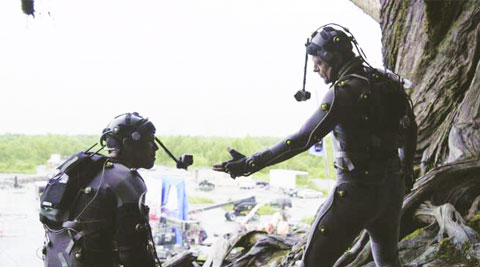Click here to follow Screen Digital on YouTube and stay updated with the latest from the world of cinema.
Dawn of Planet of Apes marks digital lib for actors
How director Matt Reeves has pushed the boundaries of motion capture to achieve photo-reality in rendering the apes, particularly in their facial expressions in the film
 Actors Andy Serkis (R) and Toby Kebbell, seen in their roles as apes Caesar and Koba from the upcoming film Dawn of the Planet of the Apes
Actors Andy Serkis (R) and Toby Kebbell, seen in their roles as apes Caesar and Koba from the upcoming film Dawn of the Planet of the Apes
It’s not easy playing an ape, even a highly intelligent one, but if Andy Serkis succeeds in captivating moviegoers, he will be thanking the obscure world of “motion capture,” a digital technology that accurately translates performance into animation.
For Dawn of the Planet of the Apes, that opened in U.S. theaters on July 11, director Matt Reeves says he pushed the boundaries of motion capture to achieve “photo-reality” in rendering the apes, particularly in their facial expressions.
In doing so, Dawn… could usher in a new age for actors, allowing them to dream of delivering award-worthy dramatic performances using a technology generally utilised in sci-fi blockbusters.
“One of the hardest things to do is to create characters that are emotionally engaging and truthful,” said Serkis, a British actor who has become a seminal figure for motion capture by bringing to life creatures such as Gollum in Lord of the Rings and King Kong. Serkis said advancements now mean that a character’s facial expressions and emotions have a “one to one” relation to the actor’s.
In motion (or “performance”) capture, multiple cameras record an actor playing scenes in a suit covered in hundreds of dot-like sensors, often against a green screen that visual effects artists then digitally transform into locations. The cameras capture the movements and feed them to computer software, where digital-effects artists animate characters accordingly.
For Dawn…, Reeves eschewed the green screen and instead had the actors playing apes don their motion-capture suits on location, interacting with the actors playing humans. Once filmed, the scenes featuring the apes were sent off to the New Zealand-based company Weta Digital ( Lord of the Rings and The Hobbit films.)
The Weta artists digitally layered ape qualities, from their anatomy to fur to movements, onto the faces and bodies of the actors. Lighting was often key to the illusion: each individual strand of fur and the glint in the apes’ eyes responded to the light of the forest. Serkis’ many screen credits have earned him respect among the film-making community and fans of the franchises, but he has yet to be recognised in the awards race for his motion-capture roles.
He attributes this to a perception by the industry that motion capture is digitally driven and not creditable to the cast. Serkis believes things will change if more people are aware of how the animator’s artistry is married to the actor’s.
“To deliver an emotionally engaging performance, does an actor have to be seen on screen? That’s the big question. It is important that the role of the actor is acknowledged,” he said.
That could dawn on audiences soon. “For the first time, there is the option of very faithfully replicating the performance of what the actor delivered on set,” said Paul Debevec, chief visual officer at the USC Institute of Creative Technology. Lightstage is derived from the technology used to age and to make Brad Pitt younger in 2008’s The Curious Case of Benjamin Button, which earned Pitt an Oscar nomination for best actor, a notable moment for digitally enhanced performances.
Most recently, while Sandra Bullock and George Clooney weren’t transformed in Alfonso Cuaron’s Gravity, they were placed into outer space using Lightstage performance capture. Bullock was nominated for best actress at this year’s Oscars, and Cuaron won best director.
The majority of big-budget films coming up over the next few years, from August’s Teenage Mutant Ninja Turtles to the next installments of the Avengers, Avatar and Star Wars franchises—Serkis also has a leading role in the latter — will be using performance-captured leading characters.
“It’s the most liberating tool for an actor, because you can never be typecast – you can play anything beyond your height, your shape, your sex, your color,” Serkis said.
U.N. Women names actress Emma Watson goodwill ambassador
The United Nations’ gender equality body UN Women has appointed British actress Emma Watson, best known for her role as Hermione in the Harry Potter film series, as a goodwill ambassador to advocate for the empowerment of young women.
“Being asked to serve as UN Women’s Goodwill Ambassador is truly humbling,” Watson, 24, said in a statement. “Women’s rights are something so inextricably linked with who I am, so deeply personal and rooted in my life, that I can’t imagine an opportunity that is more exciting,” she said.
Watson’s films have grossed more than $5.4 billion worldwide over the past decade, according to the Internet Movie Database. She graduated from Brown University in May with a bachelor’s degree in English literature. Other UN Women goodwill ambassadors include Oscar-winning actress Nicole Kidman and Thailand’s Princess Bajrakitiyabha Mahidol.
- 01
- 02
- 03
- 04
- 05


































